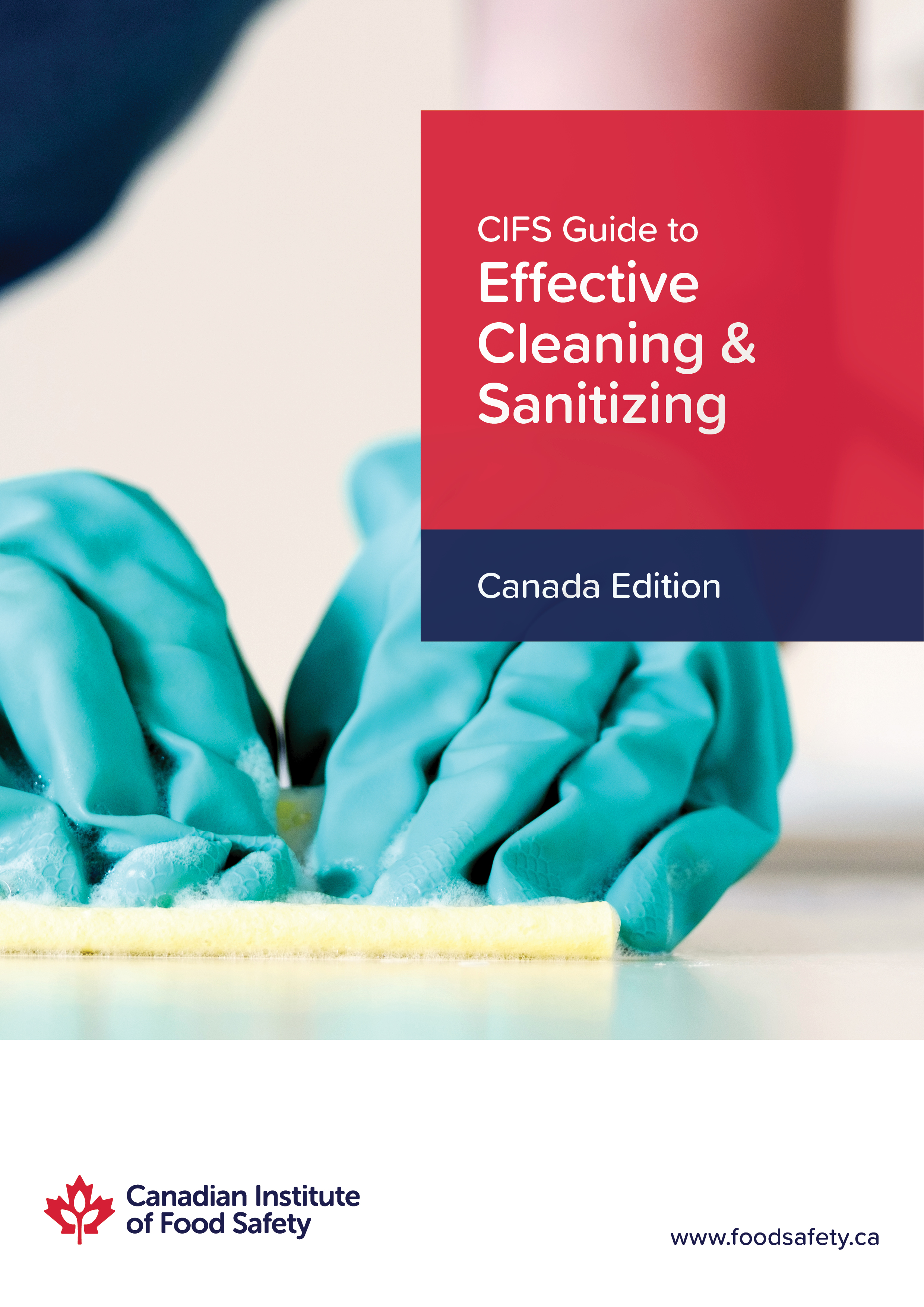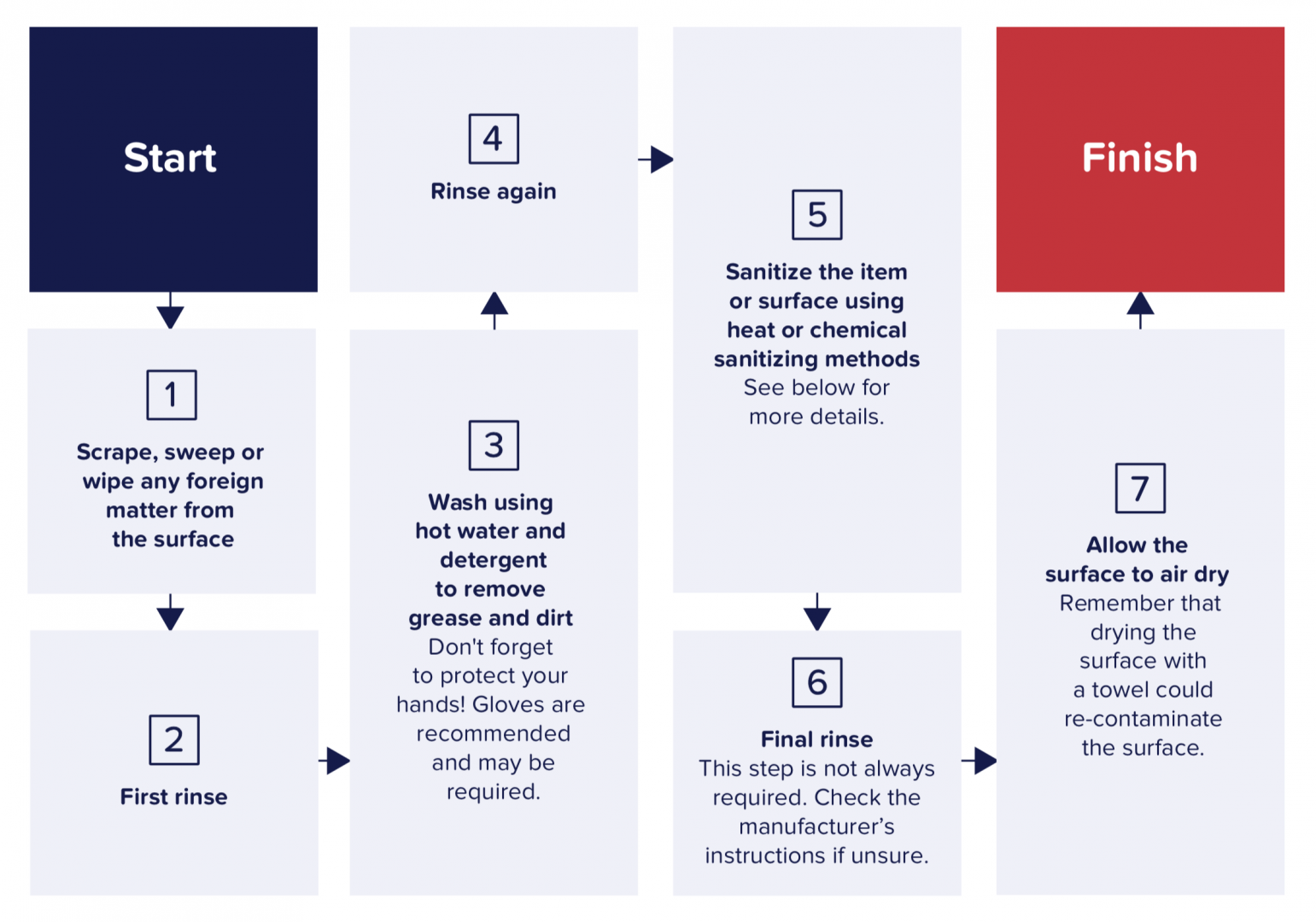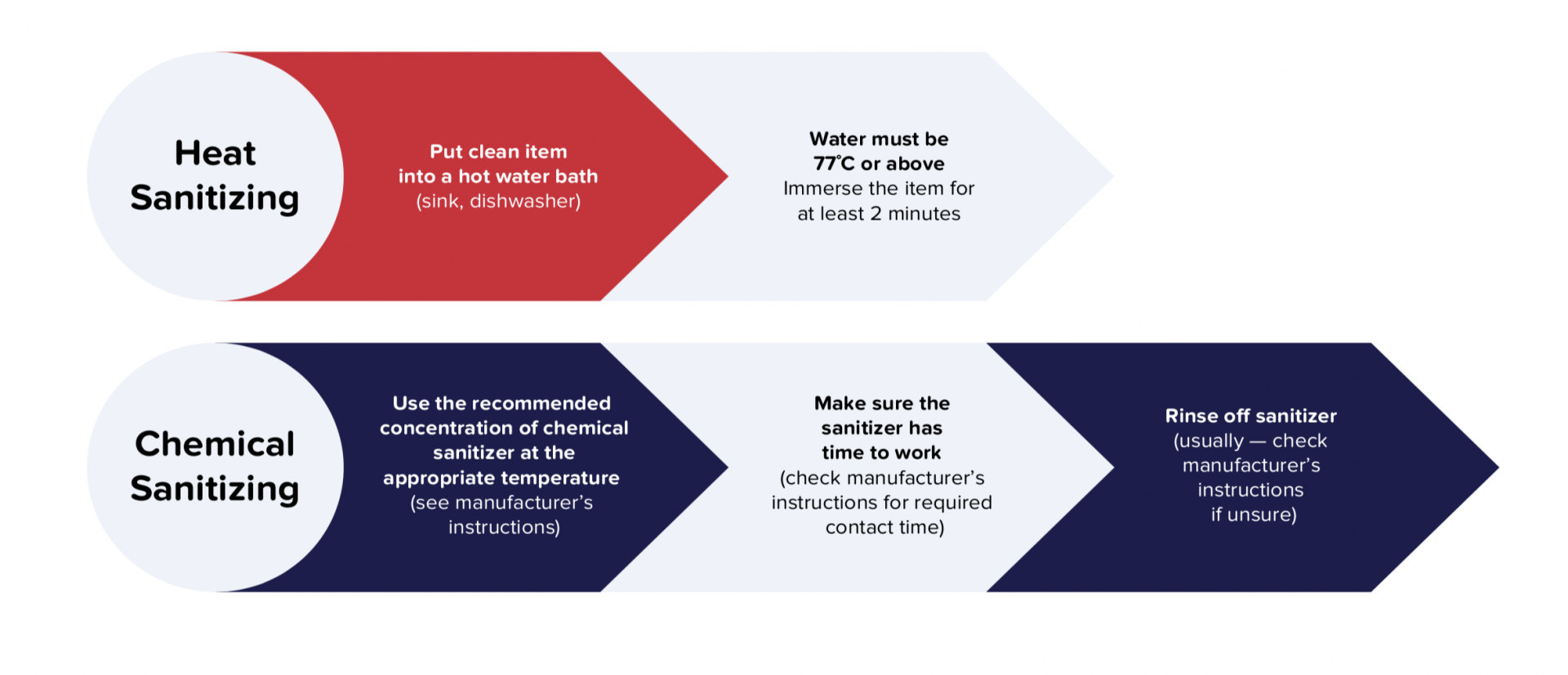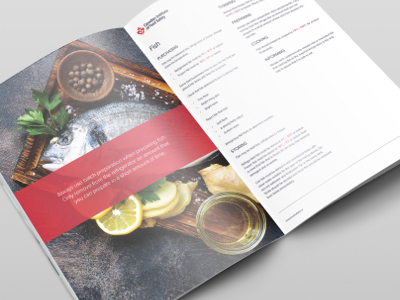
This guide was developed to provide you with knowledge of safe workplace cleaning and sanitizing practices.
Good workplace hygiene demands effective, frequent and regular cleaning and sanitizing of premises and equipment. This is necessary to remove food residues and dirt which may contain harmful bacteria and other microorganisms that can cause food-borne illness.
In This Resource
Introduction
This guide was developed to provide you with knowledge of safe workplace cleaning and sanitizing practices. Good workplace hygiene demands effective, frequent and regular cleaning and sanitizing of premises and equipment. This is necessary to remove food residues and dirt which may contain harmful bacteria and other microorganisms that can cause food-borne illness.
While something may look clean, it may not necessarily be clean or safe to use. To protect customers from food-borne illness, food businesses need to ensure that all Food Handlers:
- meet high standards of personal hygiene
- know the difference between cleaning and sanitizing
- effectively maintain cleaning and sanitizing procedures
Most people who work in a food business think that cleaning and sanitizing is simply a matter of common sense. They try to do the right thing; however, they often risk the safety of customers by cutting corners when cleaning and sanitizing dishes, equipment and workstations.
Safe food handling is not limited to how you transport, store, prepare and serve food; it also involves rigorous and regular cleaning and sanitization practices.
RESPONSIBILITIES OF FOOD HANDLERS
As a Food Handler, it is important that you are aware of your responsibility to maintain hygienic work premises. It is necessary to do the following:
- Understand the difference between cleaning and sanitizing and put this knowledge into practice at all times.
- Purchase the appropriate cleaning and sanitizing products for use in kitchens. It is important to understand why this is important, even if you are not directly responsible for ordering these products.
- Follow the manufacturer’s instructions for the use of cleaning and sanitizing products; never improperly mix chemicals and cleaning products.
- Understand that cutting corners on cleaning and sanitizing procedures can have serious consequences. For example:
- Microorganisms can spread and multiply to unsafe levels, increasing the risk of food poisoning.
- Chemical residue can contaminate food, ruining the taste of food and potentially making a customer ill.
- Perform the necessary tasks required for effective cleaning and sanitizing. For example:
- Do not dilute products below concentrations recommended by the manufacturer.
- Allow enough contact time for cleaning and sanitizing products to take effect.
- Know how to perform simple visual checks to examine the effectiveness of cleaning and sanitization practices. For example:
- Check that equipment is visually clean and shiny.
- Check that food display cabinets, shelves and corners are free of food scraps, dirt and other debris.
WHY IS CLEANING & SANITIZING IMPORTANT?
The purpose of cleaning and sanitizing is to prevent the growth of bacteria on surfaces and equipment used to process, store and transport food. Cleaning and sanitizing also discourages pest infestations, as most pests are attracted to food scraps, crumbs and odours in food preparation and service areas. Cleaning and sanitizing is also important to create a safe working environment for staff and to present a good image to customers.
WHAT SHOULD I CLEAN & SANITIZE?
All equipment and surfaces that have direct contact with food must be cleaned and sanitized thoroughly and regularly to avoid the build-up of bacteria. All crockery, cutlery and glassware used to serve food to customers must also be cleaned and sanitized regularly. Remember that walls, doors and even windows in the food preparation area can harbour bacteria, along with front of house items such as chairs, tables and service counters.
WHEN DO I NEED TO CLEAN & SANITIZE?
Any items that have direct contact with food should be cleaned and sanitized after each use. This is especially important when you are changing from working with raw foods to cooked or ready-to-eat foods. Floors, sinks and benches also need to be cleaned and sanitized regularly; your Food Safety Program should have procedures detailing how often.
Steps to Effective Cleaning and Sanitizing
Cleaning and sanitizing is a critical process for ensuring the safety of your customers and employees. Cleaning and sanitizing is a two-step process:
STEP 1: CLEANING
Cleaning is the process of removing all food residues, dirt, grease and other visible matter and odours from all fixtures, fittings and equipment.
We recommend implementing a clean-as-you-go policy. A clean-as-you-go policy keeps work areas, tools, equipment and staff clean and tidy at all times while working. This may include cleaning up spills, wiping down surfaces and removing waste into bins throughout a Food Handler’s shift, as opposed to the end of it (or not at all).
Cleaning is done using detergent, however it doesn’t kill bacteria or the pathogens that cause food poisoning. To kill bacteria and ensure a clean workplace, you must follow cleaning with sanitizing.
STEP 2: SANITIZING
Sanitizing is the process of reducing the number of bacteria and other microorganisms to a safe level. Sanitizing is required for all food contact surfaces and eating utensils.
It is vitally important that all items used to serve food to customers are cleaned, sanitized and kept dry. The sanitizing process can be performed by applying heat, chemicals or both.
When sanitizing with heat (using hot water), the higher the temperature, the shorter the contact time required. Chemicals, when used as a sanitizer, need to be used at the correct concentration, temperature and contact time.
It is important to understand that if preparation benches, surfaces and equipment are only physically cleaned (wiped down), bacteria can survive and multiply. Keep in mind that wiping a surface from one end to the other can actually spread bacteria across a greater surface area, so breaking it down into smaller sections is most effective.
Sanitizing is most effective on clean surfaces, free from dirt, grease and food particles. The sanitizing process will not kill all bacteria, but it will reduce the number to a safe level by public health standards.
The Cleaning & Sanitizing Process

The Two Sanitizing Methods
Whether you choose the heat or chemical sanitizing method, follow the steps below for optimal results:

Tips for Using Sanitizers Effectively
Sanitizers appropriate for use in food preparation areas must be purchased and used according to the manufacturer’s instructions to ensure that:
- the risk of chemical contamination is removed
- the chemical sanitizer is suitable for contact with food and will not leave a chemical residue after use (for example, methylated spirits are not to be used)
- the sanitizer is effective when used at the recommended concentration
When sanitizing food preparation surfaces and equipment (benches, mixers, utensils), it’s important to always follow the below process:
- Wipe down the equipment with a clean cloth that has not been used on any other equipment or surfaces (avoid cross-contamination).
- Wash the equipment with hot soapy water.
- Rinse the equipment to remove cleaning chemicals and any extra food waste that may have been missed when wiping and washing.
- Apply sanitizer following the manufacturer's instructions.
- Allow to air dry (using a dish towel could recontaminate the item).
When cleaning and sanitizing dishes and utensils with a commercial dishwasher, use the following steps:
- Scrape and rinse away food particles on dishes before placing them in the dishwasher.
- Check detergent, sanitizer and rinse aid levels before starting a wash cycle.
- Have the dishwasher on the hottest washing settings.
- Allow the dishwasher and dishes to air dry after cleaning.
- Visually check dishes when removed from the dishwasher to ensure they are clean.
- Clean the dishwasher every day, following your machine’s specific cleaning guidelines.
Proper maintenance of your commercial dishwasher will help to limit the spread of harmful bacteria. Most manufacturers recommend that staff perform the below tasks:
- Open the dishwasher door after having finished using it for the workday and allow it to air dry overnight.
- Ensure the filter is clean.
- Change the filter approximately every 20 cycles, or more often if your machine is used more frequently than usual.
- When you change the filter, replace the water in the tank to ensure dishes come out clean every time. Remember to clean the interior tank with an approved cleaning solution.
- Never use any chemicals that may damage the machine. For example, bleach (and some other types of chemicals) should never be used in a commercial dishwasher. The user manual will have guidelines on which chemicals to use to clean the machine.
In addition to keeping your commercial dishwasher clean, it’s important to keep it in good repair. Schedule annual inspections from a certified dishwasher technician to ensure that your dishwasher is working optimally. The technician will be able to replace any broken parts or diagnose other hidden problems you may not have noticed.
Maintaining a Cleaning & Sanitizing Schedule
For food businesses to effectively clean and sanitize the entire premises, it is important to have a written schedule that defines how all surfaces, equipment and utensils are to be cleaned and sanitized. The cleaning and sanitizing schedule should include:
- written instructions
- details of equipment and areas to be cleaned and sanitized
- how frequent cleaning and sanitizing should be done
- person(s) responsible
- cleaning and sanitizing agents (concentration, temperature and contact time)
- precautions against the contamination of food and ingredients
In a successful cleaning and sanitizing program, staff must be properly trained and also receive refresher training on a regular basis.
You should also implement a checklist system to ensure that the proper procedure is being followed, and no steps are forgotten. Staff should also be instructed to perform visual checks as they go. Visual checks should ensure that:
- items are free of any foreign material
- there are no signs of chemical/cleaning residue, for example, cloudy or dull residue (surface should be shiny)
- the surface is dry
Not following procedures or taking shortcuts can contaminate the food that you sell.
Good Personal Hygiene
It is essential that Food Handlers maintain good personal hygiene as part of the cleaning and sanitizing practices in their workplace.
Wiping down a bench with a cloth that has been in contact with unwashed hands after sneezing or coughing increases the risk of cross-contamination. Cross-contamination can be the cause of food-borne illness. For example, pathogens from your hands transfer to cleaning cloths, then to work surfaces, then to food being prepared, and then to customers after eating the prepared food.
A common practice to avoid cross-contamination is to ensure all Food Handlers practice correct hand washing techniques.
Creating a Culture of Food Safety
Successful food businesses incorporate routine checks into their daily schedules to ensure cleaning and sanitizing is being done correctly. It’s important to observe staff while performing their cleaning and sanitizing duties and inspect their work afterward.
If staff are not following cleaning and sanitizing procedures, it may be time to refresh your business’s training programs. Online Food Handler Certification will help staff to understand why cleaning and sanitization are important to reduce food-borne illness and how to clean and sanitize properly.




